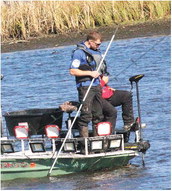Juedes murder trial set for 2021


A month-long jury trial has been scheduled to start in October of 2021 in the 14-year-old murder case of Ken Juedes. Cindy Juedes Schulz, 66, faces a charge of first-degree homicide in the death of her husband, who was found shot to death on Aug. 30, 2006, at their home in the town of Hull. Juedes-Schulz, who had been living in Chippewa Falls, was arrested almost exactly a year ago, on Nov. 27, 2019, and is being held in Marathon County Jail on a $1 million bond. It is unclear what new evidence, if any, surfaced last fall that led to her arrest, but detectives interviewed her at her home for seven hours about a month before she was arrested.
At a hearing on Monday before Judge Michael Moran, the court set Oct. 11, 2021, as the start date of the jury trial, which is scheduled to last until Nov. 12.
A full-day motion hearing was also set for Feb. 19 so Judge Moran can consider a variety of motions filed by district attorney Theresa Wezsteon and assistant attorney general Robert Kaiser.
Defense attorney Earl Gray has until Jan. 4, 2021, to file responses to the motions, and prosecutors have until Jan. 15 to file responses in writing.
On Nov. 11, prosecutors submitted two motions — one to admit non-testimonial statements and another to submit “other acts,” referring to evidence of prior behavior that may implicate the defendant. Prosecutors previously submitted a pair of motions on Sept. 4, seeking to bar evidence implicating a third party in the murder and to preempt any arguments regarding the defendant’s mental state at the time of the crime In the first motion, the prosecutors point out that Gray has referred to calling out-of- state witnesses who may contest their extradition. The prosecution sees as an indication that the defense “will be accusing those witnesses of having committed the offense with which the defendant is charged.”
The prosecutors point out that Wisconsin courts have established a “bright line standard” for introducing third-party suspects that requires the defense to show evidence of motive, opportunity and “direct connection” to the crime.
In a Sept. 16 letter to the court, Gray noted that he has not filed a notice of a third-party perpetrator, and he won’t make that decision until a trial date is set and he contacts witnesses.
“Then, if I believe I have sufficient evidence to present a third party perpetrator notice, I will file one,” he wrote. “Until that time, I am unable to ethically or competently respond to the state’s motion.”
The prosecution’s second motion seeks to prevent the defense from introducing evidence regarding Schulz-Juedes’ “mental state.”
Included in the motion is evidence that she may have lied about a doctor finding “spots” on her brain shortly before the murder. According to a medical report attached to the motion, a CAT scan per- formed at Memorial Medical Center on Aug. 25, 2006, shows “no intracranial abnormalities” The prosecutors point out that the burden is on the defense attorney if he wants to introduce other evidence of psychological or neurological issues — in a way that is not designed not to simply garner sympathy with the jury.
In another development, Detective Dennis Blaser of the Marathon County Sheriff’s Department obtained a search warrant in June to review digital surveillance footage from in and around the Juedes property in the weeks leading up to the Aug. 30 homicide.
The video could contain evidence of criminal activity and “assist in determining the relationship between the victim and his wife in the days leading up to the victim’s death,” Blaser wrote.
Gray also noted in one of his filings that the prosecution has sent handwriting samples to the FBI for analysis, and he would like time to find his own handwriting expert if that is the case.
“The state has had 14 years to prepare its case and is still looking for witnesses while my client languishes in jail,” he said.


